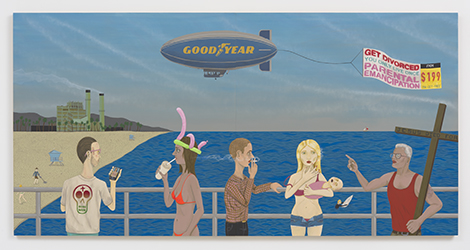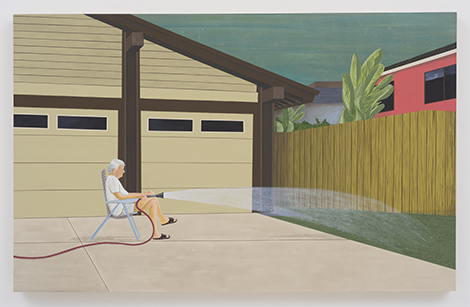Ed Templeton has expressed his obsession with watching people who walk along the sidewalks and hang out at the waterfront in Huntington Beach, California. He is equally fascinated by young girls and old men, their modes of dress or undress, and the details of their surroundings. Templeton, who is well-known as a photographer as well as a professional skateboarder, composites his observations into figurative paintings that explore the nuances of the human condition to express a wide range of humanity.
The paintings are often inspired by Templeton’s photographs. A photograph of a man watering his lawn from a lawn chair was the catalyst for the body of work titled “Synthetic Suburbia.” The image conjured David Hockney’s A Lawn Sprinkler (1967) in Templeton’s mind— with the addition of the human element. Man Waters Lawn, Suburbia (all works 2015) depicts a complacent elderly man seated on a plastic lawn chair casually watering a patch of green lawn adjacent to his paved driveway—a perfect suburban moment. Templeton reduces the space depicting the scenario into a realistic, yet stylized illustration. Templeton’s painting style is flat and direct, akin to Alex Katz. Both artists take a minimal approach to representation: one based on line and form rather than on brushstroke or paint application. Woman Walks Poodles is based on the combination of a photograph of a woman walking her two poodles and an image of a topiary tree. Templeton merged these disparate images, augmenting the shapes of the trees to parallel the poodles’ coiffures. A casually-clad woman in black high-top converse sneakers stares out at the viewer as if to say, “leave me alone, I am just out walking my dogs, there is nothing unusual about this moment.”

Ed Templeton
Huntington Beach Pier #2 (Get Divorced), 2015, Acrylic on panel
48 x 96 in (121.92 x 243.84 cm), Courtesy of the artist and Roberts & Tilton, Culver City, California.
Templeton is an astute voyeur who recognizes the unusual as well as the banal in his surroundings and is capable of transforming these isolated moments, gestures and expressions into representational paintings that collectively become a portrait of Huntington Beach, his Huntington Beach. While some of the paintings depict isolated figures against a solid colored ground— Bubble Man, Smoking Girl, Leopard Skin Tights, Woman with Cane—it’s the paintings of people on the pier that most successfully convey Templeton’s admiration of the peculiarity of this environment. The paintings Huntington Beach Pier #1 and Huntington Beach Pier #2 capture this array of people, birds and anomalies — a Goodyear blimp towing a “get divorced” banner, billowing smoke from a nearby power plant— that mark the idiosyncrasies of this locale.
Templeton’s respect and fascination for this world of peers and strangers is evident in his tenderly-painted depictions. His beach paradise is more dystopic than utopic, yet it is those distinctions and contradictions that compel him to record what he witnesses, heightening reality beyond the photographic. In his black-and-white photographs he hones in on isolated moments: women in bikinis, couples kissing, a lone body surfer, a homeless encampment, whereas in his paintings he composites these elements to create narratives that illustrate the beauty and the complexities of beach culture.


